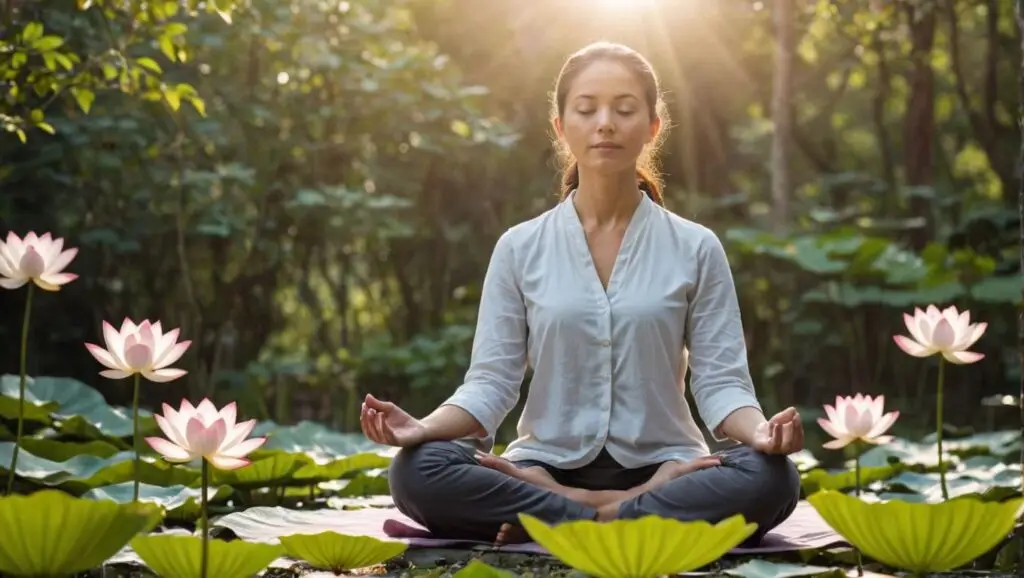Discover proven techniques for relieving SAD symptoms in our mindful living guide. Nurture your mind, body, and soul today

Table of Contents

1. Proven Techniques: Understanding Seasonal Affective Disorder (SAD)
Overview of SAD and Its Symptoms Seasonal Affective Disorder (SAD) is a type of depression that occurs at specific times of the year, typically during the fall and winter months when daylight hours are shorter. Symptoms of SAD include persistent low mood, lack of energy, irritability, changes in appetite and sleep patterns, difficulty concentrating, and a loss of interest in activities once enjoyed. These symptoms can significantly impact daily functioning and overall well-being.
Causes and Risk Factors Associated with SAD Several factors contribute to the development of SAD, including:
- Reduced Sunlight Exposure: Shorter days and longer nights in the fall and winter can lead to decreased exposure to natural sunlight, affecting the body’s internal clock (circadian rhythm) and reducing the production of serotonin, a neurotransmitter that regulates mood.
- Biological Factors: Individuals with a family history of depression or other mood disorders are at a higher risk of developing SAD.
- Geographical Location: Living in regions with long winters and limited sunlight increases the likelihood of experiencing SAD.
- Gender and Age: Women are more likely to be affected by SAD than men, and young adults are at a higher risk than older adults.
How SAD Affects Mental and Physical Health SAD can have a profound impact on both mental and physical health. Mentally, it can lead to feelings of sadness, hopelessness, and anxiety. Physically, individuals may experience fatigue, changes in appetite and weight, and disturbances in sleep patterns. The combination of these symptoms can reduce the overall quality of life and hinder daily activities.

2. Proven Techniques: Light Therapy for SAD Relief
Benefits of Light Therapy for SAD Light therapy, also known as phototherapy, is a widely used and effective treatment for SAD. It involves exposure to bright light that mimics natural sunlight, helping to regulate the body’s internal clock and increase serotonin production. Benefits of light therapy include:
- Improved Mood: Light therapy can alleviate depressive symptoms and improve overall mood.
- Increased Energy Levels: Exposure to bright light can boost energy and reduce feelings of fatigue.
- Better Sleep Patterns: Light therapy can help regulate sleep patterns and improve sleep quality.
How to Choose and Use a Light Therapy Box When selecting a light therapy box, consider the following factors:
- Brightness: Choose a light therapy box with a brightness level of at least 10,000 lux.
- UV Protection: Ensure the box filters out harmful UV rays to protect your skin and eyes.
- Size and Portability: Consider the size and portability of the box for ease of use at home or work.
To use a light therapy box effectively:
- Timing: Use the box in the morning for about 20-30 minutes to simulate natural morning sunlight.
- Distance: Sit about 16-24 inches away from the box, ensuring the light reaches your eyes without looking directly at it.
- Consistency: Use the light therapy box daily during the fall and winter months for optimal results.
Tips for Incorporating Light Therapy into Your Daily Routine
- Morning Routine: Make light therapy a part of your morning routine by using the box while eating breakfast, reading, or working.
- Create a Schedule: Set a regular time each day for light therapy to establish consistency.
- Combine with Other Techniques: Enhance the benefits of light therapy by combining it with other SAD management techniques, such as physical activity and healthy eating.
3. Proven Techniques: Embracing Physical Activity and Exercise
Importance of Physical Activity for Mental Health Regular physical activity plays a crucial role in maintaining mental health and well-being. Exercise has been shown to release endorphins, which are natural mood lifters, and reduce levels of stress hormones such as cortisol. Engaging in physical activity can help alleviate symptoms of depression, anxiety, and stress, making it an effective strategy for managing Seasonal Affective Disorder (SAD). Additionally, exercise improves overall energy levels, enhances sleep quality, and promotes a sense of accomplishment and self-efficacy.
Best Exercises for Combating SAD
- Aerobic Exercises: Activities like running, swimming, cycling, and brisk walking are great for elevating heart rate and boosting mood. These exercises increase the production of endorphins and improve cardiovascular health.
- Strength Training: Incorporating strength training exercises, such as weightlifting, resistance bands, and bodyweight exercises, can help build muscle, improve metabolism, and enhance overall physical strength and confidence.
- Mind-Body Exercises: Yoga, tai chi, and Pilates are excellent for combining physical activity with mindfulness. These practices focus on breath control, flexibility, and mental relaxation, making them ideal for combating stress and promoting mental clarity.
Tips for Staying Active During Winter Months
- Indoor Workouts: Utilize indoor workout options like home exercise videos, fitness apps, and online classes. Create a dedicated workout space at home to stay motivated.
- Join a Gym: Consider joining a gym or fitness center that offers a variety of classes and equipment. Group fitness classes can provide social interaction and support.
- Set Realistic Goals: Establish achievable fitness goals and track your progress. Celebrate small victories to stay motivated and maintain consistency.
- Dress Appropriately: If you prefer outdoor activities, dress in layers to stay warm and protect yourself from the cold. Invest in appropriate footwear and gear for winter conditions.
- Stay Accountable: Partner with a workout buddy or join a fitness group to stay accountable and motivated. Encourage each other to stay active and share progress.

4. Proven Techniques: Maintaining a Balanced Diet
Nutritional Impact on Mood and Energy Levels A balanced diet is essential for maintaining mood and energy levels, particularly during the winter months when SAD symptoms are prevalent. Proper nutrition supports brain function, stabilizes blood sugar levels, and provides the energy needed to carry out daily activities. Consuming a variety of nutrient-dense foods can help alleviate symptoms of depression and anxiety, making it a key component of SAD management.
Foods That Help Alleviate SAD Symptoms
- Omega-3 Fatty Acids: Foods rich in omega-3 fatty acids, such as fatty fish (salmon, mackerel), flaxseeds, walnuts, and chia seeds, have been shown to improve mood and reduce symptoms of depression.
- Vitamin D-Rich Foods: Since reduced sunlight exposure can lead to vitamin D deficiency, incorporating vitamin D-rich foods like fortified dairy products, mushrooms, and egg yolks can help maintain adequate levels.
- Complex Carbohydrates: Whole grains, legumes, and vegetables provide sustained energy and help stabilize blood sugar levels, reducing mood swings and fatigue.
- Antioxidant-Rich Foods: Berries, leafy greens, nuts, and seeds are rich in antioxidants that combat oxidative stress and support brain health.
- Tryptophan-Rich Foods: Foods like turkey, chicken, tofu, and bananas contain tryptophan, an amino acid that boosts serotonin production and improves mood.
Meal Planning Tips for a Balanced and Mood-Boosting Diet
- Plan Ahead: Create a weekly meal plan that includes a variety of nutrient-rich foods. Prepare meals in advance to ensure you have healthy options readily available.
- Balanced Meals: Aim for balanced meals that include a source of protein, healthy fats, and complex carbohydrates. Incorporate colorful fruits and vegetables for added nutrients.
- Hydration: Stay hydrated by drinking plenty of water throughout the day. Herbal teas and infused water can be enjoyable alternatives.
- Mindful Eating: Practice mindful eating by paying attention to your hunger and fullness cues. Avoid distractions while eating and savor each bite.
- Limit Processed Foods: Minimize the consumption of processed and sugary foods that can lead to energy crashes and mood swings.

5. Proven Techniques: Practicing Mindfulness and Meditation
Benefits of Mindfulness and Meditation for SAD Mindfulness and meditation are powerful tools for managing Seasonal Affective Disorder (SAD). These practices promote relaxation, reduce stress, and enhance overall mental well-being. By focusing on the present moment and cultivating awareness, mindfulness and meditation help to regulate emotions and improve mood. Regular practice can lead to reduced symptoms of anxiety and depression, increased self-awareness, and a greater sense of inner peace.
Simple Meditation Practices for Beginners
- Mindful Breathing: Sit comfortably and focus on your breath. Inhale deeply through your nose and exhale slowly through your mouth. Pay attention to the sensations of each breath, letting go of any distractions.
- Body Scan Meditation: Lie down or sit comfortably. Slowly scan your body from head to toe, noticing any areas of tension or discomfort. Breathe into each area and visualize releasing tension with each exhale.
- Loving-Kindness Meditation: Sit comfortably and silently repeat phrases of kindness and compassion to yourself and others. For example, “May I be happy, may I be healthy, may I be at peace.” Extend these wishes to loved ones and even to people you find challenging.
- Guided Visualization: Listen to a guided meditation that takes you on a calming journey through peaceful imagery, such as a forest, beach, or mountain.
Integrating Mindfulness into Daily Life
- Mindful Morning Routine: Start your day with a few minutes of mindfulness. Practice deep breathing, set positive intentions, or engage in a brief meditation session.
- Mindful Eating: Pay full attention to the experience of eating. Notice the colors, textures, and flavors of your food. Eat slowly and savor each bite.
- Mindful Walking: Take a walk and focus on the sensations of walking. Notice the feeling of your feet touching the ground, the rhythm of your steps, and the sights and sounds around you.
- Gratitude Practice: Take a few moments each day to reflect on things you are grateful for. Write them down in a gratitude journal to cultivate a positive mindset.
Prompt: “Proven Techniques: Practicing Mindfulness and Meditation – An image of a person meditating in a peaceful outdoor setting with elements like lotus flowers and soft light.”
- Alt Text: A person meditating in a peaceful outdoor setting with lotus flowers and soft light.
6. Proven Techniques: Seeking Professional Help and Support
Importance of Consulting a Healthcare Professional Seeking professional help is crucial for effectively managing Seasonal Affective Disorder (SAD). A healthcare professional can provide an accurate diagnosis, recommend appropriate treatments, and offer support tailored to your specific needs. Early intervention and professional guidance can prevent symptoms from worsening and improve overall quality of life.
Types of Therapy and Counseling for SAD
- Cognitive-Behavioral Therapy (CBT): CB is a highly effective therapy for SAD. It focuses on identifying and challenging negative thought patterns and behaviors, replacing them with positive and constructive ones. CB can help individuals develop coping strategies and improve their mood.
- Interpersonal Therapy (IPT): IPT focuses on improving interpersonal relationships and communication skills. It helps individuals navigate social challenges and build a strong support network.
- Alternative Therapies: Various alternative therapies, such as art therapy, music therapy, and acupuncture, can complement traditional treatments and provide additional support for managing SAD.
Finding Support Groups and Community Resources
- Support Groups: Joining a support group can provide a sense of belonging and understanding. Connecting with others who share similar experiences can offer emotional support and practical advice.
- Community Centers: Local community centers often offer mental health resources, workshops, and group activities that can help individuals manage SAD.
- Online Resources: Numerous online platforms provide access to virtual support groups, forums, and educational materials related to SAD. These resources can be valuable for those who prefer remote support.
7. Proven Techniques: Utilizing Natural Remedies and Supplements
Herbal Remedies for Managing SAD Symptoms Herbal remedies can be a natural and effective way to manage the symptoms of Seasonal Affective Disorder (SAD). Some popular herbal remedies include:
- St. John’s Wort: Known for its antidepressant properties, St. John’s Wort can help alleviate symptoms of mild to moderate depression. It is important to consult with a healthcare professional before using it, as it can interact with other medications.
- Lavender: Lavender is renowned for its calming and anxiety-reducing effects. Using lavender essential oil in aromatherapy or consuming it as a tea can promote relaxation and improve mood.
- Chamomile: Chamomile tea is a popular remedy for anxiety and insomnia. Its soothing properties can help reduce stress and promote better sleep.
- Rhodiola Rosea: This adaptogenic herb can help combat fatigue and enhance mood by reducing stress and boosting energy levels.
Vitamins and Supplements That Support Mental Health Certain vitamins and supplements play a crucial role in supporting mental health and alleviating SAD symptoms:
- Vitamin D: Since reduced sunlight exposure during winter can lead to vitamin D deficiency, supplementing with vitamin D can help improve mood and overall well-being.
- Omega-3 Fatty Acids: Found in fish oil supplements, omega-3 fatty acids have been shown to reduce symptoms of depression and improve brain function.
- B Vitamins: B vitamins, particularly B6, B12, and folate, are essential for brain health and can help regulate mood and energy levels.
- Magnesium: Magnesium is known for its calming effects and can help reduce anxiety and improve sleep quality.
Safe and Effective Usage of Natural Remedies
- Consult with a Healthcare Professional: Before starting any herbal remedies or supplements, it is important to consult with a healthcare professional to ensure they are safe and appropriate for your individual needs.
- Follow Recommended Dosages: Adhere to the recommended dosages on product labels or as advised by a healthcare provider. Avoid taking excessive amounts, as this can lead to adverse effects.
- Monitor Progress: Keep track of your symptoms and monitor how you respond to the natural remedies. Adjust dosages or discontinue use if necessary, based on your healthcare provider’s guidance.
- Be Aware of Interactions: Some herbal remedies and supplements can interact with medications or other supplements. Inform your healthcare provider of any other treatments you are using to avoid potential interactions.
8. Proven Techniques: Establishing a Consistent Sleep Routine
Impact of Sleep on Mental Health and SAD Sleep plays a vital role in maintaining mental health and well-being. Poor sleep quality and irregular sleep patterns can exacerbate symptoms of Seasonal Affective Disorder (SAD) and contribute to feelings of depression and anxiety. Adequate and restful sleep is essential for mood regulation, cognitive function, and overall physical health. Establishing a consistent sleep routine can help improve sleep quality and mitigate the impact of SAD.
Tips for Improving Sleep Quality and Consistency
- Create a Sleep-Friendly Environment: Ensure your bedroom is conducive to sleep by keeping it dark, quiet, and cool. Use blackout curtains, white noise machines, or earplugs to minimize disruptions.
- Set a Regular Sleep Schedule: Go to bed and wake up at the same time every day, even on weekends. Consistency helps regulate your body’s internal clock and improve sleep patterns.
- Limit Screen Time Before Bed: Reduce exposure to screens (phones, tablets, TVs) at least an hour before bedtime. The blue light emitted by screens can interfere with the production of melatonin, a hormone that regulates sleep.
- Avoid Stimulants: Limit the consumption of caffeine, nicotine, and other stimulants in the hours leading up to bedtime. These substances can disrupt sleep and make it harder to fall asleep.
- Practice Relaxation Techniques: Engage in relaxation techniques such as deep breathing, progressive muscle relaxation, or meditation to unwind and prepare your mind and body for sleep.
Creating a Bedtime Routine for Better Sleep
- Wind Down with a Routine: Establish a calming bedtime routine that signals to your body that it is time to sleep. This can include activities like reading, taking a warm bath, or listening to soothing music.
- Limit Heavy Meals and Alcohol: Avoid heavy meals and alcohol close to bedtime, as they can disrupt sleep and lead to discomfort.
- Stay Active: Regular physical activity during the day can help improve sleep quality. Aim for at least 30 minutes of moderate exercise most days of the week, but avoid vigorous exercise close to bedtime.
- Use Comfortable Bedding: Invest in a comfortable mattress and pillows that support restful sleep. Choose bedding that keeps you at a comfortable temperature throughout the night.
- Keep a Sleep Diary: Track your sleep patterns, bedtime routine, and any factors that may be affecting your sleep. Use this information to make adjustments and improve your sleep habits.
9. Proven Techniques: Engaging in Social Activities and Building Connections
Importance of Social Interactions for Mental Well-Being Social interactions play a vital role in maintaining mental well-being and combating symptoms of Seasonal Affective Disorder (SAD). Engaging with others can provide emotional support, reduce feelings of loneliness, and enhance overall happiness. Meaningful social connections can also offer opportunities for shared experiences, laughter, and positive reinforcement, contributing to improved mood and resilience during challenging times.
Ideas for Staying Socially Connected During Winter
- Virtual Gatherings: Organize virtual meetups with friends and family using video conferencing platforms. Host virtual game nights, movie watch parties, or group chats to stay connected.
- Join Clubs and Classes: Participate in online clubs, classes, or workshops that align with your interests. Whether it’s a book club, cooking class, or fitness group, these activities can provide a sense of community and engagement.
- Volunteer: Volunteering for local organizations or online initiatives can help you connect with others while making a positive impact. It can also provide a sense of purpose and fulfillment.
- Social Media Groups: Join social media groups or forums focused on shared hobbies or interests. Engage in discussions, share experiences, and build connections with like-minded individuals.
- Outdoor Activities: If weather permits, participate in outdoor activities with friends or family, such as hiking, skating, or building snowmen. Fresh air and physical activity can boost mood and strengthen social bonds.
Building a Support Network to Combat Isolation
- Reach Out to Friends and Family: Regularly check in with loved ones through phone calls, texts, or video chats. Share your feelings and experiences and encourage them to do the same.
- Attend Support Groups: Join support groups for individuals experiencing SAD or other mental health challenges. These groups can provide a safe space for sharing and receiving support.
- Create a Routine: Establish a routine that includes regular social interactions. Schedule virtual or in-person meetups to ensure consistent social engagement.
- Be Open and Honest: Communicate openly with your support network about your needs and challenges. Let them know how they can best support you.
- Seek Professional Help: If you struggle with feelings of isolation, consider seeking guidance from a mental health professional. They can provide strategies and resources to help you build and maintain social connections.
10. Proven Techniques: Setting Realistic Goals and Practicing Self-Compassion
Benefits of Setting Achievable Goals for Mental Health Setting realistic and achievable goals can have a positive impact on mental health by providing a sense of purpose, direction, and accomplishment. Clear and attainable goals can boost motivation, build self-confidence, and enhance overall well-being. Achieving small goals can lead to a sense of progress and satisfaction, contributing to a positive mindset and resilience.
Strategies for Practicing Self-Compassion and Self-Care
- Be Kind to Yourself: Treat yourself with the same kindness and understanding that you would offer to a friend. Acknowledge your efforts and progress, even if they seem small.
- Practice Self-Care: Prioritize self-care activities that nourish your mind, body, and soul. This can include activities like taking a relaxing bath, reading a book, or spending time in nature.
- Set Boundaries: Establish healthy boundaries to protect your time and energy. Learn to say no to commitments that may overwhelm you and prioritize activities that bring you joy and fulfillment.
- Reflect and Reframe: Reflect on your thoughts and feelings and reframe negative self-talk into positive affirmations. Challenge self-critical thoughts and replace them with compassionate and supportive statements.
- Celebrate Achievements: Take time to celebrate your achievements, no matter how small. Recognize your progress and give yourself credit for your efforts.
Overcoming Negative Self-Talk and Fostering a Positive Mindset
- Identify Negative Patterns: Pay attention to negative thought patterns and identify triggers. Understanding the root of negative self-talk can help you address and challenge it.
- Use Positive Affirmations: Incorporate positive affirmations into your daily routine. Repeat statements that reinforce your worth, capabilities, and strengths.
- Focus on Strengths: Shift your focus from perceived weaknesses to your strengths and accomplishments. Keep a journal of your achievements and positive experiences.
- Practice Gratitude: Cultivate gratitude by reflecting on the positive aspects of your life. Keep a gratitude journal and write down things you are thankful for each day.
- Seek Support: Talk to a trusted friend, family member, or therapist about your feelings. They can provide perspective, encouragement, and support in overcoming negative self-talk.
I hope this detailed section on engaging in social activities, building connections, and setting realistic goals while practicing self-compassion provides valuable insights and practical tips for managing SAD.
Share this content:
